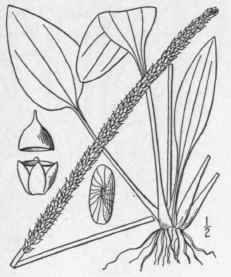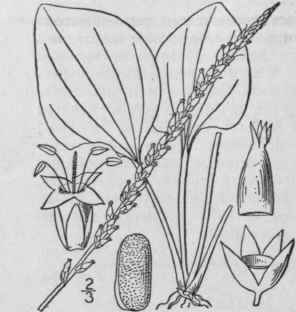1. Plantago [Tourn.] L. Sp. Pl. 112. 1753
Description
This section is from the book "An Illustrated Flora Of The Northern United States, Canada And The British Possessions Vol3", by Nathaniel Lord Britton, Addison Brown. Also available from Amazon: An Illustrated Flora of the Northern United States, Canada and the British Possessions. 3 Volume Set..
1. Plantago [Tourn.] L. Sp. Pl. 112. 1753
Acaulescent or leafy-stemmed herbs, the scapes arising from the axils of the basal or alternate leaves, bearing terminal spikes or heads of small greenish or purplish flowers (flowers solitary in a few exotic species). Calyx-segments equal, or two of them larger. Corolla salverform, the tube cylindric, or constricted at the throat, the limb spreading in anthesis. Fruit a pyxis, mostly 2-celled. Seeds various. [The Latin name.]
Over 200 species, of wide distribution. Besides the following, some 6 others occur in western North America. Known as Plantain, Ribwort or Roadweed. Type species: Plantago major L.
* Plants acaulescent; flowers spicate or capitate at the ends of scapes. Corolla-lobes spreading or reflexed in fruit, not closed over the top of the pyxis. Leaves ovate, lanceolate or oblong.
Seeds several or many in each pyxis.
Pyxis ovoid, circumscissile at about the middle.
1. P. major.
Pyxis oblong, circumscissile much below the middle.
2. P. Rugelii.
Seeds 2-4 in each pyxis.
Leaves all narrowed at the base, parallel-ribbed. Seeds excavated on the inner side.
3. P. lanceolata.
Seeds flat or but slightly concave on the inner side. Spike very dense; leaves pubescent.
4. P. media.
Lower flowers scattered: leaves glabrous or very nearly so.
5. P. enopoda.
Leaves, or some of them, cordate: veins starting from the midrib.
6. P. cordata.
Leaves linear or filiform.
Leaves fleshy; plant maritime.
7. P. maritima.
Leaves not fleshy; plants not maritime.
Spike densely tomentose; bracts usually not longer than flowers.
8. P.Purshii.
Plant green and glabrate; bracts much longer than the flowers.
9. P. aristata.
Corolla-lobes erect and closed over the top of the pyxis. Leaves spatulate to obovate; stamens 4.
10. P. virginica.
Leaves linear-filiform; stamens 2.
Capsule about 4-seeded, slightly exceeding the calyx.
11. P. pusilla.
Capsule 7-30-seeded, twice as long as the calyx.
12. P. heterophylla.
** Stem erect, leafy; flowers capitate at ends of axillary peduncles.
13. P. arenaria.
1. Plantago Major L. Common Or Greater Plantain. Dooryard Plantain
Fig. 3898
Plantago major L. Sp. Pl. 112. 1753.
Perennial, glabrous or somewhat pubescent; rootstock short, thick, erect. Leaves long-petioled, rather firm in texture, mostly ovate, obtuse or acutish, entire, or coarsely dentate, 1'-10' long, 3-11-ribbed; scapes 2.'-3° high; spike linear-cylindric, usually very dense, commonly blunt, 2'-10' long, 3"-4" thick; flowers perfect, proterogynous; sepals broadly ovate to obovate, scarious on the margins, one-half to two-thirds as long as the ovoid obtuse or subacute, 5-16-seeded pyxis, which is circumscissile at about the middle; stamens 4.
In waste places, nearly throughout North America. In part naturalized from Europe, but indigenous in the North and on salt meadows. Also in the West Indies. Small leaves are occasionally borne near the bases of the spikes; spikes rarely branched. May-Sept. Way-side or round-leaf plantain. Broad-leaf. Hen-plant. Lamb's-foot. Way-bread. Healing-blade.

Plantago halophila Bicknell, of saline situations along the Atlantic coast, is densely pubescent, but otherwise like this species. A similar race occurs about lakes in northern New York.
Plantago asiatica L. is a boreal race with thinner nearly erect leaves.

Continue to:


